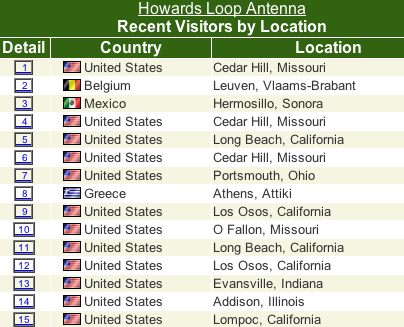
Another pretty good website
|
Howard Henderson of Kirkwood, Missouri is a HAM with call letters W0ZJR. He recently moved to an apartment building, losing the large back yard antenna at his previous residence. In order to stay on the air and keep in touch with his network of airplane building friends, Howard built an antenna that can be carried on the top of his Chevy van and quickly set up at remote locations. Using an article in the March, 2007 issue of QST by John Portune, W6NBC, for the basic design, Howard built a tilt-up compact HF loop, mostly of 3/4 inch copper pipe -- with some PVC pipe and fittings. Today, November 2, 2007, Howard and I set up the antenna in my driveway in Byrnes Mill. Within minutes he was chatting with a number of HAMs in Waco, Texas and one Milwaukee, Wisconsin. Howard was very pleasantly surprised at how well he could transmit and receive, commenting that performance was better than he had ever experienced at his previous residence.
With the very successful first test, we will design and build a rig to securely hold the antenna on the car's roof -- and make it quick and easy to put up and take down. (We might even refine the seat and desk used in today's trial.) Howard will soon be back on the air on a regular schedule.
We've designed and built the first version of the roof-top mount for the loop antenna. On Saturday, Nov. 10, Howard set up the rig in my driveway and made contact with his EAA net. Here are some photos taken at that event. While Howard was transmitting, I made a cell phone call to test for possible interference. There was none. I did not photograph the antenna in its "folded" (or horizontal) position. When folded forward, the antenna is supported by the wooden framework. The framework fits neatly onto the van's roof rack where it and the antenna will usually reside "full time." The wooden framework will be fastened to the roof rack in at least four places with heavy-duty plastic "tie-wraps." To set up the antenna for use, it is easily pushed to vertical using the diagianl brace (made of 1/2 inch Schedule 40 PVC tube.) Then the lower end of the diaginal is pinned to the frame. The upper end of the diagonal is permanently connected to the antenna with one bolt -- serving as a pivot. (We "wrapped" the copper tube with another layer of copper soldered in place to reinforce the pipe where the diagonal attched. Now I wish we had inserted a 10 inch long piece of "Corian" -- or equal -- inside the tube before drilling.) In the folded position, the same pin is moved, and used to hold the PVC tube alongside the antenna itself. (So there is nothing "loose" to be misplaced.) With the antenna vertical, cables are run to the battery and the balen is connected to the antenna with alligator clips. (I'm sure the battery connection could be via the "cigarette lighter" recepticle, as most modern cars offer this connection for use with various electrical accessories.)
Following photos made December 4, 2007:
This is the pin that holds the diagonal support in place when the antenna is folded for transport. The same pin is used to secure the base of the diagonal when it is supporting the antenna in its vertical position. (Battery connections are now made via the cigarette lighter recepticle.) When we first posted this page, we sent its link to antenna designer John Portune and received this reply: 
The first 15 visitors to this page included web surfers from Geece, Mexico and Belgium:  Find the location of other visitors to this page. If you click on the small counter number below, SiteMeter will display some information about (up to 100 of) our most recent visitors. Hint: Click on "By World Map" in SiteMeter's left column. Then click on "100" under the map. The World Map you access will look something like this one that was "clipped" at SiteMeter:
|


















